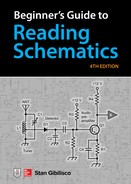Book Description
This updated resource shows how to interpret schematic diagrams—and design your own
Written by an experienced engineer, this easy-to-follow TAB guide shows, step-by-step, how to navigate the roadmaps of electronic circuits and systems. Filled with new illustrations and DIY examples, the book clearly explains how to understand and create high-precision electronics diagrams. You will discover how to identify parts and connections, interpret element ratings, and apply diagram-based information in your own projects. Beginner’s Guide to Reading Schematics, Fourth Edition, also contains valuable appendices covering symbols, resistor color codes, and parts suppliers.
Up-to-date coverage includes:
•Block, schematic, and pictorial diagrams
•Resistors and capacitors
•Inductors and transformers
•Switches, relays, conductors, and cables
•Diodes, transistors, Op amps, and logic gates
•Electron tubes , cells, and batteries
•Voltage dividers and reducers
•Simple and complex circuits
•Breadboards and wire wrapping
•Electronics troubleshooting
•Digital electronics and functional circuits
•And much more
